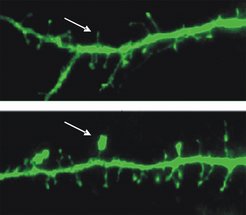Hairstyle of a neuron: from hairy to mushroom-head
A mechanism that controls synapse formation unraveled
Synapses are essential for the brain's normal function: their absence or presence is tightly linked to the brain's ability to transfer, process, and store information. Synapses are thus constantly generated and degraded. However, the mechanisms of this complex remodelling process remained largely unknown. Scientists of the Max Planck Institute of Neurobiology have now identified the molecular players involved in synapse formation (Nature Neuroscience, February 2007).

One of the most prominent traits of the brain is its ability to learn and to store information. To do so, nerve cells might need to either create new sites of contact, the synapses, or to disable such sites again. For example, an increase in synaptic contacts between nerve cells is attributed to learning, while their loss can signify the loss of information. As a consequence, the total number of synapses varies constantly - not only in the developing, but also in the adult brain. This synaptic plasticity is now known as one of the key mechanisms of learning and memory processes.
To form a new synapse, hair-like filaments on opposing nerve cells differentiate into dendritic spines, each composed of a stalk which supports a large head. Information transfer between nerve cells is then possible through these enlarged spine heads. However, the mechanisms that control this conversion of a thin filament into a functional dendritic spine have until now remained a mystery.
The Max Planck scientists Inmaculada Segura, Clara Essmann, Stefan Weinges and Amparo Acker-Palmer have succeeded in unravelling one of these complex mechanisms. To achieve this, they concentrated their investigations on a specific group of receptors and their membrane-bound binding partners. Amazingly, the binding partners can also function as receptors in this system. This "reverse signalling" plays an important role in the modification of the cytoskeleton and thus in the formation of dendritic spines. The Max Planck scientists were able to identify the molecular components which control this cytoskeleton remodelling. These exciting insights into the control of synapse formation advance our knowledge of the mechanisms involved in learning and information storage by one important step.












